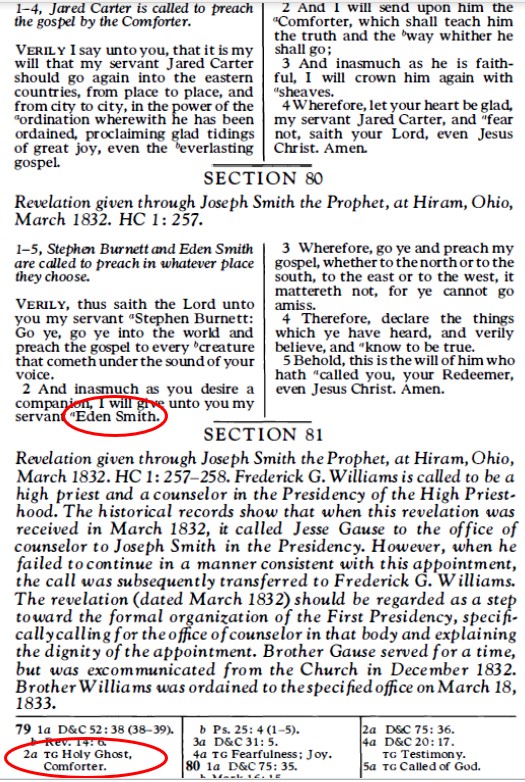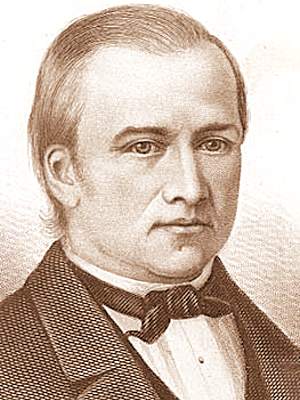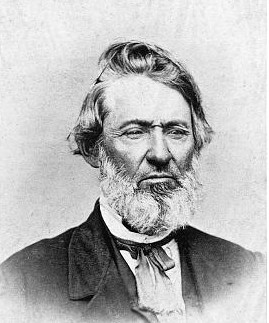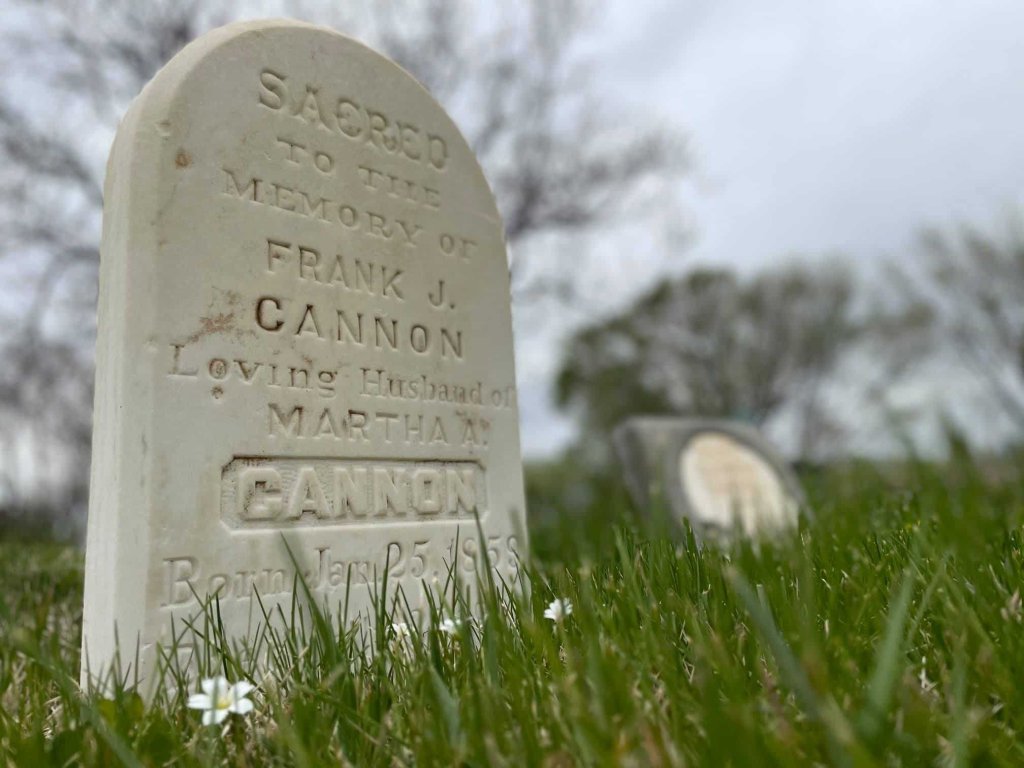-
•
•
In addition to written records, people leave behind traces of their material lives that can tell us much about who they were. In a recent interview with Kurt Manwaring, Mark Staker (a Master Curator for the Church History Department’s Historic Sites Division) discussed some of the research he has been doing on the place Joseph Smith’s parents lived early in their marriage (which he also discussed in the recently-published Joseph and Lucy Smith’s Tunbridge Farm: An Archaology and Landscape Study [John Whitmer Historical Association, 2021]). What follows here is a co-post to the full interview (a shorter post with excerpts and some… Read More
-
•
•
4 responses
“The world is changed. … Much that once was is lost, for none now live who remember it. … And some things that should not have been forgotten were lost. History became legend. Legend became myth. And for two and a half thousand years, the [true Gospel] passed out of all knowledge. Until, when chance came, it ensnared another bearer.” While not the same, the overall character of the opening monologue for Peter Jackson’s Lord of the Rings is compatible with the Latter-day Saint view of the Great Apostasy. It was, after all, a time of loss and change. As… Read More
-
•
•
4 responses
Orson Hyde asks people to read his book. Or else. Read More
-
•
•
4 responses
One of the paradoxes about the Word of Wisdom is that the name (drawn from the opening line of the text from the 27 February 1833 revelation) indicates that it is good advice while it’s treated as a commandment in the Church today. I’ve discussed this in detail in the past, so I’ll leave the full subject to that treatment as well as the historians of the Joseph Smith Papers Project, but the short version is that it’s not clear when the revelation became a commandment for members of the Church. It may have been intended as a commandment all… Read More
-
•
•
3 responses
While studying in a scientific field, two major ideas were drilled into me that have been fairly helpful in interpreting history. First is the belief that nothing can ever truly be proved, only that things can be disproved. If something goes a long time without being disproved, then it is likely (though not certainly) to be an accurate understanding of how something works. Second is the idea of backing things up with data. For biological studies, those data often looks like measured levels of chemicals in a sample or cell counts, but in history, data is mostly based around finding… Read More
-
•
•
As one of Joseph Smith’s largest revelations, Doctrine and Covenants, Section 88 (or, as Joseph Smith called it, “the Olieve leaf which we have plucked from the tree of Paradise”) has a lot of different talking points. As historian Richard Lyman Bushman wrote: “Nothing in nineteenth-century literature resembles it. … The ‘Olive Leaf’ runs from the cosmological to the practical, from a description of angels blowing their trumpets to instructions for starting a school. Yet the pieces blend together into a cohesive compound of cosmology and eschatology united by the attempt to link the quotidian world of the now to… Read More
-
•
•
Orson Hyde might be protesting too much here. Read More
-
•
•
12 responses
I’ve long had an interest in understanding how and why my ancestors chose to practice polygamy. During my time at Utah State University, I spent most of my spare time reading Mormon Studies materials and went on a polygamy binge at one point. While reading Kathryn Daynes’s More Wives Than One: Transformation of the Mormon Marriage System, 1840-1890 during some downtime in the laboratory, a visiting biologist from Pakistan saw what I was reading and asked if I was preparing to take a second wife. I wasn’t quite sure how to respond, so explained that I was not and tried… Read More
-
•
•
2 responses
Joseph F. Merrill is an apostle who has largely been forgotten but who, nevertheless, left a major impact on the Church that remains a part of its DNA to this day. Kurt Manwaring recently sat down for an interview with Merrill’s biographer, Casey Griffiths, to discuss his life and impact. It’s an interesting discussion and can be viewed in full here. What follows below is a co-post, a shorter discussion with excerpts from the full interview. Before Kurt shared the interview with me, I was only dimly aware of Merrill’s impact, mostly encountering him as the mission president of Gordon… Read More
-
•
•
2 responses
Words can be a bit slippery, particularly when we use them in different ways over time. Take, for example, the use of the word “ordinance” in the Church. In its most basic sense, an ordinance is an authoritative order; a decree or a piece of legislation (think of a city ordinance). It seems very possible that many of the time when the word occurs in the Doctrine and Covenants, the word is used in this manner, referring to the laws or decrees of God. On other occasions, the term may be used as an appointment or commission (in what is… Read More
-
•
•
7 responses
For Hyde, Zion has been displaced, but not deferred. Read More
-
•
•
One response
Joseph Smith’s presidential campaign has been an area of interest for several years now (particularly since the release of the Council of Fifty minutes), and Spencer W. McBride’s recently-published Joseph Smith for President: The Prophet, the Assassins, and the Fight for American Religious Freedom (Oxford University Press, 2021) is the latest in scholarship to be published on the subject. McBride recently sat down with Kurt Manwaring for an interview where he offered some of his insights. What follows here is a co-post to that interview (a short version with excerpts and some discussion), but the original interview can be found… Read More
-
•
•
10 responses
In both the Vision studied recently (D&C 76) and the first revelation studied this week (D&C 77) there is a mysterious figure referenced as Elias. Throughout the remainder of his ministry, Joseph Smith would use this name-title to refer to individuals who served as forerunners with preparatory or restorative responsibilities. But, at times, it also seemed as though he had a specific individual in mind, possibly drawing on references to the name Elias used in the King James Version of the New Testament. Who was this person? How did Joseph Smith understand his role? The revelation now known as D&C… Read More
-
•
•
13 responses
But I’m still glad we don’t have one. Read More
-
•
•
11 responses

One day while I was serving my mission, my companion told me that he knew the name of the Holy Ghost. I told him I was doubtful, but he insisted that it was Eden. He opened his scriptures to Doctrine and Covenants, Section 80, pointed to Eden Smith’s name, and told me to look at the footnote (2a). I did so and was surprised to see that it indicated that Eden Smith was indeed the Holy Ghost. I found this very confusing and worked on puzzling out this mystery for a minute or two before finally figuring out what was… Read More
-
•
•
8 responses
As I was working on my previous post, I had a thought I wanted to explore, but not enough space there: If we believe in eternal progression but also want to argue that there are limits to upward mobility in the eternities, we run into the question—why? Why wouldn’t it be possible to continue repenting and progressing after resurrection and judgement? While there’s a lot of potential answers (God said so, lower motivation to work on things in this life, etc.), one of the more interesting answers from Church leaders caught my attention as something to ponder. That answer was… Read More
-
•
•
14 responses
One of the methods that paleontologists use to understand the age of a fossil in relation to other fossils at a site is by looking at layers, or strata. The basic idea is that layers build up over time, with organisms becoming part of the sediment layers as the organisms die and get buried while the sediments continue to build up, then become fossilized over time. Since layers build upwards, older layers will generally be found lower in the strata levels, with the newer layers being superimposed on top. Thus, each layer provides a snapshot of what was living (and… Read More
-
•
•
4 responses
The experience of persecution in Missouri was not just recent history. For Hyde, it was the literal fulfillment of prophecy about the last days. Read More
-
•
•
Poetry for this week’s Come Follow Me lesson, D&C section 76, The Vision of the Celestial Kingdom — plus, was Joseph Smith a poet? Read More
-
•
•
5 responses
It can be easy at times, when studying the early history of the Church through the lens of the Doctrine and Covenants, to forget that there was a whole life and existence in the Church outside of the main gathering places in Ohio and Missouri. We spend so much time following Joseph Smith and his companions that the lives of those not immediately around him can fall by the wayside. Even when studying later periods, it can be easy to forget that there were times during the mid-1800s that the majority of Church members actually lived in Britain rather than… Read More
-
•
•
7 responses
Some years ago, I attended a course on the Pearl of Great Price at the Logan Institute that could have just as easily been entitled “Teachings of Hugh Nibley.” The teacher was well-versed in Nibley’s writings and frequently used them in discussing both the Book of Moses and the Book of Abraham. And, frankly, it made the class quite interesting to attend because of the insights the teacher shared from his reading of Hugh Nibley’s works. In part because of the things that Nibley wrote, he has garnered attention as a widely-known figure of the 20th century in the Church… Read More
-
•
•
22 responses
If you survey the damage left by Donald Trump and Covid-19 in our neighborhood of the American religious landscape, a sigh of relief is warranted. Read More
-
•
•
One response

Poetry for this week’s Come Follow Me lesson, D&C sections 71-75, addressing Criticism, Consecration and Proclamation Read More
-
•
•
Poetry for this week’s Come Follow Me lesson, D&C sections 67-70, addressing The Lord’s Witness, Inspiration, and Parenting Read More
-
•
•
2 responses
At this point in the year, we’ve finally caught back up with the context of where we began—Section 1. The conference in early November 1831 (at which Sections 1, 67 and 68 were recorded) was focused on publishing the revelations that Joseph Smith had been—a project which would come to be known as the Book of Commandments and later The Doctrine and Covenants. It is, perhaps, inevitable in a religious movement that believes in both being led by prophets and that everyone can receive revelation that there are going to be tensions about who is able to speak for the… Read More
-
•
•
4 responses
Orson Hyde, socialist? Read More
-
•
•
5 responses
Hyde touches on his own life and perspective for the first time. Read More
-
•
•

Poetry for this week’s Come Follow Me lesson, D&C sections 64-66, addressing Forgiveness, Zion’s Ensign and Our Thoughts Read More
-
•
•
5 responses

“The lack of any biography of Frank Cannon seemed a glaring gap in [Utah] annals. It was high time to tell his story.” Val Holley recently stated this during an interview with Kurt Manwaring where they discussed Frank Cannon and Holley’s recently-published biography, Frank J. Cannon: Saint, Senator, Scoundrel (University of Utah Press, 2021). What follows here is a co-post to that interview, with quotes and some commentary. Feel free to read the full interview here. In summarizing Frank Cannon’s accomplishments, Holley stated that: Frank Cannon was Utah’s first U.S. senator after it became a state in 1896. During the 50… Read More

